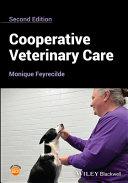Cooperative Veterinary Care, 2nd Edition připravuje se

Každé zvíře potřebuje lékařskou péči na veterinární klinice a v pohodlí domova. Strach a stres mohou představovat významné překážky dobré péče a zároveň ohrozit výsledky terapie. Publikace má nejen teoretické základy a klade důraz na klinické poznatky. Je průkopnickým průvodcem podpory domácí veterinární péče. Publikace byla aktualizována tak, aby odrážela nejnovější zkušenosti a klinické informace čerpající z letitých profesionálních a praktických zkušeností. Publikace je nezbytnou součástí každé ordinace malých zvířat nebo veterinárních klinik, které chtějí zlepšit pohodlí pacienta a usnadní veterinární péči.
Publikace představuje jedinečný průzkum veterinárního prostředí a toho, jak může kooperativní veterinární péče pomoci při terapii.
Integrace spektra beze strachu, úzkosti a stresu ke kvantifikaci zážitků pacientů.
Krok za krokem jsou uvedeny tréninkové plány veterinární péče a metody chovu s ukázkami fotografií a videí.
Praktické aplikace pro všechny běžné postupy.
Základní techniky, které lze rozšířit prakticky na jakoukoli veterinární péči nebo potřebu chovu a péče o zvířata.
Publikace je sepsána pro profesionální veterinární tým, ale pomůže komukoli a všem, kdo se o domácí mazlíčky starají a jsou s nimi v kontaktu.
Autor: Monique Feyrecilde
| Nakladatel | Wiley-Blackwell |
|---|---|
| ISBN | 9781394163595 |
| Vydání | II. vydání 2024 |
| Vazba | brožovaná |
| Počet stran | 288 |
A new and improved edition of the original guide to veterinary care and husbandry putting the emotional welfare of animals first
Every pet needs medical care in the veterinary clinic and husbandry at home. Fear and stress can present significant barriers to good care while also compromising safety for animal care professionals and pet owners. It's possible to help pets learn to allow and even willingly participate in veterinary care, husbandry, and grooming. With a foundation in learning theory and emphasizing practical techniques, Cooperative Veterinary Care is a groundbreaking guide to encouraging voluntary participation in veterinary care. Now updated to reflect the latest research and clinical information drawing on years of professional hands-on experience, it's a must-own for any small animal practice or pet professional looking to increase patient comfort and facilitate excellent care.
Foundations of learning and training to prepare any professional to get started right away
Unique exploration of the veterinary environment and how Cooperative Veterinary Care can help
Integration of the Fear Free(sm) Spectrum of Fear, Anxiety & Stress to quantify patient experiencesStep by step training plans for veterinary care and husbandry with photo and video demonstrations
Practical applications for all common procedures.
Foundation techniques which can be expanded to virtually any veterinary care or animal husbandry and grooming need
Cooperative Veterinary Care is written for the veterinary professional team but will help anyone and everyone who cares for and interacts with pets.
Monique Feyrecilde, BA, LVT, VTS (Behavior), is a Veterinary Technician Specialist in Behavior, one of only fourteen such specialists worldwide. Her special interests are applied animal behavior of all species and proactive preventive medical care. She is also the creator and producer of Teaching Animals, based in Maple Valley, Washington, USA and online at www.teachinganimals.com. She is a veterinary behavior consultant in Seattle, Washington.
TABLE OF CONTENTS
Introduction to Low-Restraint and No-Restraint Veterinary Care
1.1 First, Do No Harm
1.2 Stress, Fear, and the Veterinary Clinic 2*Update with timely information
1.3 Freedom, Wants, and Needs
1.4 Iatrogenic Behavioral Injury
1.5 Introduction to Low] and No]Restraint Animal Care
References
2 Perception and Communication
2.1 Sensation and Perception
2.2 Stress and Fear
2.3 Body Language
2.4 Causes of Stress in the Veterinary Setting
References
3 Learning, Conditioning, and Training *Update with timely information
3.1 Classical Conditioning *Update with timely information
3.2 Operant Conditioning *Update with timely information
3.3 Habituation, Sensitization, Desensitization, Counterconditioning, and More *Update with timely information
3.4 The ABCs of Behavior
3.5 Fundamental Training Skills
References
4 Successful Visits: Environment and Protocols to Prevent Fear and Stress
Fear Free Vocabulary 2 pages
Fear Free FAS Spectrum 2 figures
Fear Free FAS and Cooperative Veterinary Care Training Levels 2 figures
How Fear Free and Cooperative Veterinary Care Intersect 2 pages
4.1 Setting Up for Success: Before the Visit
Considerate Approach
4.2 During the Visit
4.3 Happy Visits and Other Preventative Planning
4.4 Hospitalization, Treatments, Diagnostics, and Boarding
References
5 Level One Patients and Training
5.1 Introduction to the Levels of Training
5.2 Identifying Level One Patients:
Fear Free FAS 0-2
5.3 Level One Training: Dog Exam Room and Examination
5.4 Level One Training: Cat Exam Room and Examination
5.5 Level One Training: Injections and Sample Collection
5.6 Administering Medications and Grooming
References
6 Level Two Patients and Training
6.1 Level Two Training
6.2 Identifying Level Two Patients: Fear Free FAS 2-3
6.3 Level Two Training: Dog Exam Room and Examination
6.4 Level Two Training: Cat Exam Room and Examination
6.5 Level Two Training: Injections and Sample Collection
6.6 Administering Medications and Grooming
References
7 Level Three Patients and Training
7.1 Level Three Training
7.2 Identifying Level Three Patients: Fear Free FAS 4-5
7.3 Preparing to Train
7.4 Making a Training Plan *Update with timely information
7.5 Getting Started: Approach, Target, and Station - *Update with timely information"
7.6 Teaching Consent, Touch, and Restraint *Update with timely information
7.7 Muzzle Training and Elizabethan Collar Training *Update with timely information
7.8 Physical Examination Training *Update with timely information
7.9 Treatments, Sample Collection, and Imaging *Update with timely information
7.10 Grooming *Update with timely information
7.11 Additional Consent Options *Update with timely information
7.12 Chin Rest
7.13 Start Button Behaviors
7.14 Considerations for Contingencies
7.15 Impact of Motivation on Training
7.16 Level Three Cats
7.17 Station Training for Cats
7.18 Carrier Training for Cats
7.19 Unique Training Considerations for Cats
8 Additional Patient Resources
8.1 Introduction
8.2 Nutraceuticals and Pharmaceuticals
8.3 Professionals and Their Roles
References
9 Implementation Strategies
9.1 Change Is Never Easy
9.2 Proposing Change
9.3 Overcoming Obstacles: Common Concerns and Questions
9.4 Making Change for the Right Reasons
Reference